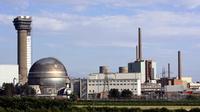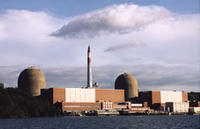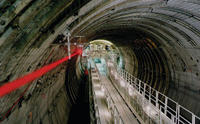-
Japan's prime minister pushes to end nuke program
Japan could soon be following in the footsteps of Germany and shut down its nuclear energy plants; at a televised press conference on Wednesday, Prime Minister Naota Kan pushed to end Japan’s nuclear program; “Japan should aim for a society that does not depend on nuclear energy,” Kan said
-
-
U.K. awards 160 million Pound nuclear decommissioning contracts

The decommissioning of one of U.K. oldest nuclear plants — Sellafield, located close to the village of Seascale on the coast of the Irish Sea in Cumbria, England — has taken a giant step forward thanks to the awarding of three waste retrieval contracts worth more than 160 million Pounds
-
-
45 percent of children in Fukushima exposed to thyroid radiation

A survey revealed that 45 percent of children living near the Fukushima Daiichi nuclear power plant have been exposed to thyroid radiation; following the nuclear disaster and the revelation that radiation was leaking from reactor no. 1, researchers tested more than 1,000 children from newborns to age fifteen in the Fukushima Prefecture; children were found to have been exposed to 0.04 microsievert per hour or less in most cases
-
-
New York governor determined to close Indian Point nuclear plant

The Indian Point nuclear power plant, located thirty-five miles north of New York City, is facing increasing pressure from Governor Andrew Cuomo and senior officials say the governor is determined to shut it down; the governor’s hand has been strengthened by new legislation that streamlines the approval process for siting new power plants in New York, a move that would make it easier to replace Indian Point; closing the nuclear plant would be a major step toward reshaping the state’s energy policy as the plant produces 2,000 megawatts and provides New York City and Westchester with 25 percent of their power — but the nuclear disaster in Japan caused by the 11 March earthquake and tsunami raised fresh concerns about the plant, which is located near a fault line
-
-
Los Alamos nuclear waste safe from wildfire
A wildfire is raging near the Los Alamos national Lab; the fire, in some places, is only yards away from the lab’s outside perimeter — and it is eight miles from the so-called Area G; the Area G site is a 63-acre storage facility where thousands of drums of nuclear waste sit, many of which are outdoors started; the good news is that there is no danger that the fire will reach Area G because in 2000, an even more intense fire burned 90 percent of the forest that covered the area between the current fire and the nuclear waste disposal site, making it impossible for the current wild fire to reach the nuclear material on storage
-
-
DHS tests three radiation detection systems at Belmont Stakes race
DHS officials recently announced that it had tested three developmental systems designed to detect radiological weapons at the Belmont Stakes horse race in New York held on Saturday, 11 June; DHS tested two mobile Stand-Off Radiation Detection Systems; the third device tested was a Roadside tracker which scans for radiation sources in vehicles
-
-
Exigent helps Navy hospital monitor radiation
Last week Exigent Security Products announced that it will supply a large amount of radiation detection systems to the National Naval Medical Center in Bethesda, Maryland; the latest shipment is the third order from the Navy medical center and is for the company’s Radiation Detection Area Monitors which will be used to monitor radioactive materials used to treat patients
-
-
Iran pushes ahead with nuke plans, despite seismic warnings
Iranian officials have chosen to ignore the warnings of top scientists and continue with the construction of nuclear facilities near earthquake prone regions; according to an official with the International Atomic Energy Agency, in a top level meeting Iran’s leaders recently decided to move ahead with plans to construct nuclear facilities, despite Iranian scientists’ warnings that “data collected since the year 2000 shows the incontrovertible risks of establishing nuclear sites in the proximity of fault lines’ in Khuzestan as well as nineteen other Iranian provinces; Iran is one of the most seismically active countries in the world with major fault lines covering at least 90 percent of it
-
-
Japanese firms purchase radiation detection devices
Universal Detection Technology (UNDT) recently announced that it has shipped radiation detection devices to companies across Japan including those in heavy industries, telecommunications, and electronics; according to UNDT, Japanese companies have been purchasing a range of devices including dosimeter systems to measure cumulative radiation exposure and advanced survey meters and surface monitors that detect the amount of contamination on surfaces
-
-
Glimmer of hope for Yucca Mountain nuclear waste repository project

Over the last twenty-five years, the United States has spent around $15 billion on the Yucca Mountain Nuclear Waste Repository which was supposed to offer a solution to the growing nuclear waste problems at U.S. nuclear power plants; in what some charged was a political move by President Barack Obama to secure Nevada’s Democratic tilt, the administration defunded the project, and funding for work on the site was terminated altogether effective with the 2011 federal budget passed by Congress on 14 April 2011; some in Congress want the project to continue, and the House Appropriations Committee has added $35 million for the project in the 2012 energy spending bill; this is far cry from past appropriations for the project — typically around $400 million a year — and even one of the supporters, Representative Mark Simpson (R-Idaho) described it as symbolic gesture; there is also a case now being heard in federal court, in which the administration is charged with overstepping its bounds by cancelling the project without congressional permission
-
-
WikiLeaks: Japan brushes aside U.S. fears of nuke terrorism
Diplomatic cables obtained by WikiLeaks reveal that U.S. officials were concerned about terrorist attacks at Japan’s nuclear facilities and the government’s seemingly lax security measures; one cable dated 26 February 2007, detailed a meeting where Japanese officials brushed aside U.S. concerns for physical security at one of the country’s nuclear facilities; additional cables sent from the U.S. Embassy in Tokyo to Washington D.C. reported that anti-terrorism drills held at nuclear facilities were unrealistic and overly “scripted”
-
-
Agreement reached on European Union stress tests
Yesterday European Union officials reached an agreement on the parameters of nuclear stress tests and will soon begin conducting safety reviews at nuclear power plants; the tests will review the resiliency of 143 nuclear facilities in the face of natural disasters like earthquakes and tornadoes in addition to terrorist attacks; the move to conduct safety reviews was triggered by the ongoing nuclear crisis in Japan; events in Japan sparked anti-nuclear protests across Europe and leaders have called for a “comprehensive and transparent risk and safety assessment” at all atomic energy facilities in the European Union
-
-
Simple method of dealing with harmful radioactive iodine discovered
Iodine radioisotopes are produced by fission of uranium fuel in a nuclear reactor; radioactive iodine is of concern because it is highly mobile in the environment and selective uptake by the thyroid gland can pose a significant cancer risk following long term exposure; furthermore, iodine-129, which is a type of radioactive iodine, has an extremely long half life of 15.7 million years, so is one of the most significant long term hazards faced by the population due to its emission during the geological disposal of nuclear waste; a University of Sheffield expert has discovered a novel way to immobilize radioactive forms of iodine using a microwave
-
-
Following Fukushima: how much radioactivity in the Oceans?
A result of the loss of electricity at the Fukushima nuclear plant in Japan on 11 March, overheating led to significant releases of iodine, cesium, and other radioisotopes to the environment; Japanese officials recently raised the severity of the nuclear power plant incident to level 7, the highest level on the international scale and comparable only to the Chernobyl incident twenty-five years ago; the National Science Foundation awards rapid-response grants to establish ocean radionuclide levels from Fukushima
-
-
EU nearing agreement on nuclear stress tests
The European Union could begin stress-testing its nuclear reactors as early as June 1; officials are nearing an agreement on the parameters for safety tests, but are still hammering out the last “two or three” issues; following the nuclear disaster at the Fukushima Daiichi nuclear plant in Japan, European energy officials as well as industry groups have been pushing the government to conduct stress tests on its nuclear facilities to determine how they will fare in various disaster scenarios; EU Energy Commissioner Guenther Oettinger has sought to include threats from terrorist attacks as well as cyber attacks, which has stalled stressed test negotiations
-
More headlines
The long view
Keeping the Lights on with Nuclear Waste: Radiochemistry Transforms Nuclear Waste into Strategic Materials
How UNLV radiochemistry is pioneering the future of energy in the Southwest by salvaging strategic materials from nuclear dumps –and making it safe.
Model Predicts Long-Term Effects of Nuclear Waste on Underground Disposal Systems
The simulations matched results from an underground lab experiment in Switzerland, suggesting modeling could be used to validate the safety of nuclear disposal sites.
